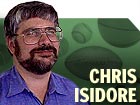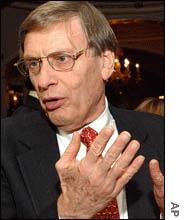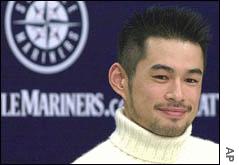|
Contraction built on myths
|
 |
November 23, 2001: 5:08 p.m. ET
No fan support in Minnesota? No good markets available? Don't believe it.
A twice weekly column by Staff Writer Chris Isidore
|
NEW YORK (CNN/Money) - Baseball is a sport filled with powerful myths - from a founding of the game in Cooperstown New York, which never actually happened, to the belief of many fans that the quality of the game today isn't as good as it was in some ill-defined "good old days."
But no collection of myths are more powerful - or more dangerous to the game - than those currently being used to argue that baseball is somehow a better and financially healthier game if it closes up two of its weaker franchises. And most of the myths are being perpetrated by Commissioner Bud Selig and the league's owners.
Myth number one is that baseball's economic structure today means that only a handful of teams - the number six is often thrown out here - have any hopes of winning a championship.
This is the silliest and most obviously incorrect myth, but it has been stated and restated so many times it is now accepted as fact by even many sports writers.
There are eight teams that make it into baseball's playoffs, and all by definition have a good chance of winning the World Series.
The eight teams that made it to the playoffs this year are all strong franchises, and it's not unreasonable to expect all to be competitive, even if the low-budget Oakland A's lose some key players to free agency this off-season.

|
|
|
Baseball Commissioner Bud Selig is depending on a number of popular myths to make his argument that contraction would be good for the game. | |
There were another five large-market teams that were competing for playoff spots in September this year, plus two more large market teams that made the playoffs as recently as 2000 before stumbling this year.
Throw in high revenue, big-budget teams in Baltimore, Colorado, Anaheim and Texas that can't blame the economic structure of the game for their woes, and you have about two thirds of the teams that obviously have the financial wherewithal to compete for a championship.
The other third of the league has more troubles, but the fact that the Minnesota Twins spent much of this year in first place is proof that even a small-market team can compete with the big boys if they make the right decisions on players. The Twins' decline this year actually occurred when they made some mid-season trades that added, rather than cut, payroll costs.
Also closing up shop in two small markets does little, if anything, to help the third of the teams that have trouble competing.
The teams don't compete head-to-head for ticket sales or television money. The bottom line of the poorer clubs would improve more if baseball moves struggling teams to better market, yielding more revenue sharing through 30 pieces of a larger pie rather than 28 pieces of a smaller pie.
Minnesota will support a team
Myth number two is that fans in Minnesota can't or won't support a competitive team unless it is playing in a new stadium.
The fact is that the Minnesota Twins, which are one of the franchises seen as a likely candidate for contraction, was the first American League franchise to ever draw 3 million fans in a season. That came in 1988. In the period from 1988 until the players' strike abruptly ended the 1994 season, the team actually outdrew the large-market New York Yankees.
A new stadium clearly isn't the answer to poor attendance. The Detroit Tigers saw a nice bump in attendance in 2000, the first year Comerica Park replaced ancient Tigers Stadium. But this year attendance fell 21 percent to end up below the 1999 attendance total.
New markets are available
The third great myth is that there is no market where a troubled franchise, such as the Montreal Expos, could relocate and find enough fan support.
Washington D.C. has a former major league stadium available, and has investors eager to build a new stadium in the Northern Virginia suburbs.
Yes, it's true that the market lost two earlier teams, after 1960 and 1971, due to poor support. But much has changed since then.
First of all Washington was a city without metro system when the last team left town, not an insignificant factor for fans wanting to attend the games.
The market has actually seen pretty healthy growth, with a greater percentage gain in population between 1990 and 2000 than such "hot" metropolitan areas as San Francisco-Oakland-San Jose, with its Silicon Valley boom during that time. Washington-Baltimore is also bigger than San Francisco-Oakland-San Jose, which already supports two teams.
While the Baltimore Orioles has threatened to fight the placement of a team in Washington, it would cost baseball less to pay the Orioles for accepting a new neighbor than it would to close up even the troubled Montreal franchise.
Other potential markets would need some time to build a new stadium. But Sacramento, Calif., and Memphis, Tenn., both have drawn near major league crowds to much smaller parks in recent years. And there are other markets supporting major league teams in other sports - such as Charlotte, N.C., and Buffalo, N.Y., in which a major league rather than minor league baseball team could top many current teams' attendance totals.
Enough players to go around
The final myth is that baseball can't find the players to fill 30 teams with quality players.
All you have to do is take a look at the league's top players in 2001 to see where baseball can find the stars it needs - overseas, and in longer careers of its established stars.
Baseball has seen tremendous growth in overseas players in the last 10 years to the point where they make up about 40 percent of the league today.
| |

|
|
Ichiro Suzuki, winner of the AL MVP and Rookie of the Year awards, is a sign that baseball has been able to find new sources of players needed to fill 30 teams. | |
Japan is the home of American League Most Valuable Player, Ichiro Suzuki, this year, and Suzuki and teammate Kazuhiro Sasaki are the last two Rookie of the Year winners. There were nine other Japanese-born players in the league in 2001, compared with the two who had played in the history of the game before the 1994 round of expansion. More Japanese stars will be here soon.
More Cuban players are finding their way here than any time since the rise of Fidel Castro, with 13 playing here this year.
Click here to see CNNSI's baseball coverage
Couple this greater geographic reach with improved training techniques and medical procedures, which have allowed players' careers to be extended. Players who likely would have been retired in an earlier era are performing at peak levels today.
The top pitchers in the two leagues this year were a 38- and a 39-year old who both depended on their fastballs, a rarity 10 years ago. The single-season home run record was set this year by 37-year old Barry Bonds, who also won the MVP award. 
Click here to send mail to Chris Isidore
|
|
|
|
|
|

|

